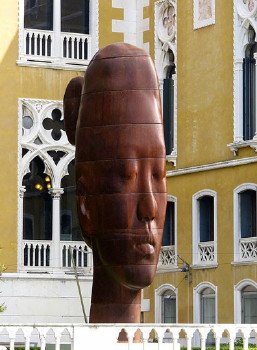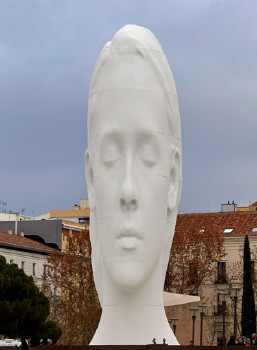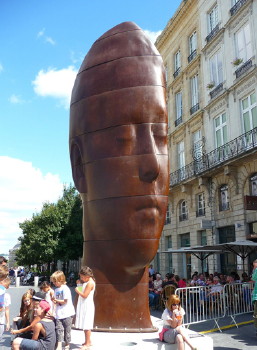stillness
The eyes look inside, not outside.
Relaxation is in the mouth, nostrils, cheeks, forehead.
The face is completely in rest.
The more I look at her face the more I become at ease.
I notice the same with others. People slow down their pace and stroll to the artwork. Unconsciously we mirror each other.
The artwork is at a location where people have an active energy.
The imperfections in the face comforts me. Just like me there is a little flaw and that is okay.
At details you can see that these people come from different continents; one has narrow eyes, the other has high cheekbones or full-lips.
Everyone is beautiful.
Vertaling
stilte
De ogen kijken naar binnen, niet naar buiten.
Er is ontspanning in de mond, neusvleugels, wangen, het voorhoofd.
De gezichten zijn geheel in rust.
Ik word steeds rustiger des te langer ik kijk naar het gezicht.
Ik merk het ook aan de ander. Mensen vertragen hun tempo en gaan bij het kunstwerk zitten. Onbewust spiegelen wij ons aan elkaar.
Het kunstwerk staat op een locatie waar mensen zijn met een actieve energie.
De imperfectie in het gezicht stelt mij gerust. Nét als bij mij is er een klein gebrek en dat geeft niet.
Aan details kun je zien dat deze mensen uit verschillende continenten komen; de ene heeft smalle oogleden, de andere hoge jukbeenderen, weer een ander volle lippen.
Iedereen is mooi.
Theo, www.artatsite.com
Duna has an oval-shaped face. Her eyes are placed obliquely. She has little bags under her eyes. She has great and gentle cheeks. Her nose comes out her forehead and has a blunt ending. It has a small upperlip. Her lower lip in a pout. She has a small double chin. She has round ears. The surface is dark gray. Would she come from The Netherlands?
Vertaling
Duna heeft een ovaal gezicht. Haar ogen zijn schuin geplaatst. Ze heeft walletje onder haar ogen. Ze heeft grote en zachte wangen. Haar neus komt voort uit haar voorhoofd en heeft een stompe beëindiging. Ze heeft een smalle bovenlip. Haar onderlip is een pruillip. Ze heeft een kleine onderkin. Ze heeft ronde oren. Het oppervlakte is donkergrijs. Zou zij uit Nederland komen?
Theo, www.artatsite.com
Compared with other artworks
Echo (link) has a round face. Her eyebrows lay high and her forehead is short. The top part of her nose lays deep, het nose tip is blunt. She has rectangular nostrils. She has a pout with plain lips. She has cheeks. She has a slim chin. She has no earlobe but connecting ears. The statue has a white surface. Would she come from Cambodia?
Vertaling
Echo (link) heeft een rond gezicht. Haar wenkbrauwen liggen hoog en haar voorhoofd is kort. De bovenkant van haar neus ligt diep, haar neuspuntje is stomp. Ze heeft rechthoekige neusvleugels. Ze heeft een pruilmondje met platte lippen. Ze heeft wangetjes. Ze heeft een slanke onderkin. Ze heeft geen oorlellen maar aansluitende oren. Het standbeeld heeft een wit oppervlakte. Zou zij uit Cambodja komen?
Love (link) is an artwork with a boys- and girls-face directed on each other. She has an oval-shaped face, large eyes, a nose that comes out of her forehead, a nosetip on an angle and long ears. The boy's eyes are closely standing, eyebrows with a firm onset, a high hair implant, a connection between the nose and the lips, an upperlip with a curved shape. Would they come from England?
Vertaling
Love (link) is een kunstwerk met een jongens- en meisjesgezicht die naar elkaar gericht zijn. Het meisje heeft een ovaal gezicht, heeft grote ogen, een neus die voortkomt uit het voorhoofd, een neuspunt onder een hoekje en lange oren. De j heeft ogen die dicht bijeen staan, wenkbrauwen met een stevige aanzet, een hoge haarinplant, een verbinding tussen neus en lippen, een bovenlip met een gewelfde vorm. Zouden zij uit Engeland komen?
Also Rui Rui (link) has a outspoken face; she has eye-catching features. She has an oval-shaped face. She has big round eyes. She has wide flat eyebrows. Her nose appears at the top of her brow, becomes wider between her eyes and concludes pear-shaped. Her cheeks are high. Two notches connect her nose and her mouth. She has broad flat lips. The middle of her ears tend to the outside. Would she come from Ghana?
Vertaling
Ook Rui Rui (link) heeft een uitgesproken gezicht; ze heeft opvallende kenmerken. Ze heeft een ovaal gezicht. Ze heeft grote ronde ogen. Ze heeft brede en platte wenkbrauwen. Haar neus verschijnt boven haar wenkbrauwen, wordt breder tussen haar ogen en beëindigt peervormig. Haar wangen liggen hoog. Twee streepjes verbinden haar neus met haar mond. Ze heeft brede en platte lippen. Het middelste gedeelte van haar oren neigen naar buiten. Zou zij uit Ghana komen?
Julia (link) has a outspoken face; she has eye-catching features. She has a long face. She has big round eyes. Her eyebrows tend upward. Her nose appears carefully between her eyes, remains slim until it meets a firm tip of the nose. She has a line on her upper lip and a long chin. She has flat cheeks. You see her bones on both sides of her head. Becase of her side parting in her hair, her face seems longer. The surface is white. Would she come from France?
Vertaling
Julia (link) heeft een uitgesproken gezicht; ze heeft opvallende kenmerken. Ze heeft een langwerpig gezicht. Ze heeft grote ronde ogen. Haar wenkbrauwen neigen omhoog. Haar neus komt heel voorzichtig tussen haar ogen tevoorschijn, blijft slank en gaat over naar een stevige neuspunt. Ze heeft lijnen langs haar boven- en onderlip en een lange kin. Ze heeft vlakke wangen. Je ziet haar beenderen aan weerzijden van haar voorhoofd. Door haar scheiding in haar haar lijkt haar gezicht langer. Het oppervlakte is wit. Zou zij uit Frankrijk komen?
Sanna (link) has no prominent features. She has an oval-shaped face. Her eyes are rather almondshaped than roun shaped. Her nose tends a little bit backwards. She has a delicate line in the middle of her upper lip. She has cheeks. Her forehead is round. She has a little double chin. The statue has a salmiak colored surface. Would she come from Scandinavia?
Vertaling
Sanna (link) heeft geen opvallende kenmerken. Ze heeft een ovaal gezicht. Ze heeft eerder amandelvormige dan ronde ogen. Haar neus neigt een beetje terug. Ze heeft een lijntje in het midden van haar bovenlip. Ze heeft wangetjes. Haar voorhoofd loopt rond. Ze heeft iets van een onderkin. Het standbeeld heeft een salmiak kleurige oppervlakte. Zou zij uit Scandinavië komen?
Theo, www.artatsite.com
www.erasmusmc-inspiratie.nl:
Lichaam en geest
'Duna is ontstaan vanuit de bezieling en het vertrouwen in de wisselwerking tussen lichaam en geest. Kijkend naar Duna kunt u zich proberen voor te stellen hoeveel mooie dingen er in ons besloten liggen. Het geeft uitdrukking aan een vervulling en bestemming in de wereld.' (bron: openingswoord Jaume Plensa op 5 december 2017).
Verstilling
Plensa's raadselachtige smalle hoofden impliceren dat wat het meeste waard is om gezien te worden zich niet buiten maar binnen onszelf bevindt. 'Kijken kan een werkelijk begrip in de weg staan', zegt de kunstenaar, 'je moet niet alleen kijken maar ook voelen.' Want het gaat volgens hem niet om de dingen als zodanig maar om wat ze teweeg brengen.
Translation:
Body and mind
'Duna originated from the inspiration and trust in the interaction between body and mind. Looking at Duna you can try to imagine how many beautiful things are containet expresses a fulfillment and destiny in the world. ' (source: opening word Jaume Plensa on December 5, 2017).
Stillness
Plensa's enigmatic narrow heads imply that what is most worthy of being seen is not outside but within ourselves. 'Looking can get in the way of a real understanding', says the artist, 'you should not only look but also feel.' Because according to him it is not about things as such, but about what they bring about.
www.erasmusmc-inspiratie.nl:
Jaume Plensa: 'Het is een erg ongebruikelijk plaats voor mij, maar ik vind het geweldig. Ik tracht voor de ziel te zorgen en ik vind het fijn dat er ook iemand voor het lichaam zorgt. Duna is gebaseerd op die dialoog tussen lichaam en geest.
Mijn speciale bedoeling is om dit beeld als een soort spiegel aan te bieden, waarin iedereen zich kan spiegelen. Om je te proberen voor te stellen hoeveel mooie dingen we binnenin ons houden.
Het ziekenhuis is een openbaar gebied, een plaats waar je kunt nadenken over de mensheid en de maatschappij. Sommige mensen lijden en sommigen hebben het geluk te weten dat alles slechts een vervelend moment was. Maar dat is het leven, en waarschijnlijk is dat de kracht van het leven. Een plaats waar je het leven ten volle ervaart. Ik hoop dat mensen bij Duna zullen samenkomen om te zitten en ervan genieten. Mijn beelden zijn ervoor om gekoesterd en aangeraakt te worden.'
Translation:
Jaume Plensa: 'It's a very unusual place for me, but I think it's great. I am seeking for a soul to take care of, I think it's great that there's a person's body. Duna is based on the dialogue between the body, mind and spirit.
My special plan for this view, as a kind of 'mirror, mirror on offer, making sure that everyone is able to flip. You have to try to imagine how many beautiful things we have inside of us to keep up.
The hospital is a public space, a place where you are able to think about the humanity and society at large. Some of the people are suffering, and some of them are lucky enough to know all of that is just a terrible time. But that's life, and it is likely that the strength of one's life. A place where you'll live life to the fullest, and gifts. I hope that the people at the Duna shall meet in order to be able to sit and enjoy it. My photos are sure to be cherished and to be touched.'
www.oregonlive.com:
The Seattle Art Museum is in the process of installing Echo, a 46-foot sculpture by internationally acclaimed Spanish artist Jaume Plensa, on the downtown waterfront in Olympic Sculpture Park.
Installation should be complete by late spring.
The sculpture is a gift from the Barney A. Ebsworth Collection. The artist has more than 30 public space installations spanning the globe in such cities as Chicago, Dubai, London, Liverpool, Tokyo, Toronto and New York, according to the Seattle Art Museum.
Echo was originally commissioned by the Madison Park Association in New York City and installed at Madison Square Park in 2011 to great acclaim. It is made from resin, steel and coated in marble dust.
Echo is named for the mountain nymph of Greek mythology who offended the goddess Hera by keeping her engaged in conversation, thus preventing her from spying on one of Zeus's amours. To punish Echo, Hera deprived the nymph of speech, except for the ability to repeat the last words of another. Plensa modeled the work after a young girl known to the artist. Rising from the center of the park with her eyes closed, it will be luminous in day and night.
In this monumental creation, Echo listens with her eyes closed in a state of meditation. From the sculpture park, she will face Puget Sound in the direction of Mount Olympus, visible from land and water.
Plensa was born in 1955 and lives in Barcelona. His most celebrated works include Crown Fountain in Chicago; Breathing at the BBC Headquarters, London; Bridge of Light, Jerusalem; and World Voices at the Burj Khalifa in Dubai.
During installation, a small portion of the Olympic Sculpture Park's bike path will be ed. The pedestrian sidewalk will remain open.
www.forbes.com:
Powerful and silent, they display serene facial expressions with their eyes closed, as if dreaming or meditating. It is a call to look inward to understand the beauty hidden inside oneself for a more honest relationship with oneself.
The 64-year-old Barcelona-based artist places utmost importance on the interaction between the audience and his work. By introducing art into the public sphere, he transforms the space and enriches a community with beauty by bringing art to all and not just to the elite.
The idea is to use ordinary people in pieces of monumental public art. Plensa's models are real people - often young girls - whose likenesses he captures using a laser scanner, before he manipulates, elongates and flattens the image using 3-D computer modeling software. The heads are stretched, like an optical illusion, as if you were looking at them from an angle. Rather than a straightforward portrait, he plays with proportions, giving a sense of spirituality to the faces, as he examines the relationship between body and soul.
Plensa repeatedly uses lexical elements in his work, where he sometimes incorporates letters and words; other times, entire quotations from classic literature by poets like Shakespeare or William Blake. 'Art many times is just a beautiful excuse to transform the way that you look at the reality around you, and it's also the idea of communication, building bridges, putting people in touch with one another,' says Plensa.
'All these elements are so important in my work. That's probably the reason why I choose alphabets for my projects. These alphabets from different cultures, all working together, create an amazing and dynamic effect of beauty. That's a very positive message to the world: how weIl we are when we are together. Obviously, I'm not able to speak many ofthe languages, but I love Japanese and Chinese. When I'm there, I listen and watch the way they write their own words. An alphabet is probably the best portrait of one culture, and to put all these alphabets together is a beautiful metaphor for our world today.'
If we have something different from animaIs, it's our capacity to talk and communicate. I love music and, for me, words are like music. The instrument is our body and we are permanently playing this music, which is our conversation. The capacity to spread words in space fills everything with energy. I love this invisible energy surrounding us, creating amazing clouds that embrace us like in a dream.
Years ago, I did a big video project in Chicago, The Crown Fountain, where I filmed 1,000 faces of people living there. During that period, I stretched faces to get exactly the proportions that I wanted. The elongation of my heads today is in exactly the same proportions that I had done in video in Chicago, but in marbIe or alabaster. 1 love this kind of elongation because it gives a certain spirituality to the person. It loses materiality in some ways; it's much lighter. It loses weight in an essential way.'
The eyes look inside, not outside.
Relaxation is in the mouth, nostrils, cheeks, forehead.
The face is completely in rest.
The more I look at her face the more I become at ease.
I notice the same with others. People slow down their pace and stroll to the artwork. Unconsciously we mirror each other.
The artwork is at a location where people have an active energy.
The imperfections in the face comforts me. Just like me there is a little flaw and that is okay.
At details you can see that these people come from different continents; one has narrow eyes, the other has high cheekbones or full-lips.
Everyone is beautiful.
Vertaling
stilte
De ogen kijken naar binnen, niet naar buiten.
Er is ontspanning in de mond, neusvleugels, wangen, het voorhoofd.
De gezichten zijn geheel in rust.
Ik word steeds rustiger des te langer ik kijk naar het gezicht.
Ik merk het ook aan de ander. Mensen vertragen hun tempo en gaan bij het kunstwerk zitten. Onbewust spiegelen wij ons aan elkaar.
Het kunstwerk staat op een locatie waar mensen zijn met een actieve energie.
De imperfectie in het gezicht stelt mij gerust. Nét als bij mij is er een klein gebrek en dat geeft niet.
Aan details kun je zien dat deze mensen uit verschillende continenten komen; de ene heeft smalle oogleden, de andere hoge jukbeenderen, weer een ander volle lippen.
Iedereen is mooi.
Theo, www.artatsite.com
Duna has an oval-shaped face. Her eyes are placed obliquely. She has little bags under her eyes. She has great and gentle cheeks. Her nose comes out her forehead and has a blunt ending. It has a small upperlip. Her lower lip in a pout. She has a small double chin. She has round ears. The surface is dark gray. Would she come from The Netherlands?
Vertaling
Duna heeft een ovaal gezicht. Haar ogen zijn schuin geplaatst. Ze heeft walletje onder haar ogen. Ze heeft grote en zachte wangen. Haar neus komt voort uit haar voorhoofd en heeft een stompe beëindiging. Ze heeft een smalle bovenlip. Haar onderlip is een pruillip. Ze heeft een kleine onderkin. Ze heeft ronde oren. Het oppervlakte is donkergrijs. Zou zij uit Nederland komen?
Theo, www.artatsite.com
Compared with other artworks
Echo (link) has a round face. Her eyebrows lay high and her forehead is short. The top part of her nose lays deep, het nose tip is blunt. She has rectangular nostrils. She has a pout with plain lips. She has cheeks. She has a slim chin. She has no earlobe but connecting ears. The statue has a white surface. Would she come from Cambodia?
Vertaling
Echo (link) heeft een rond gezicht. Haar wenkbrauwen liggen hoog en haar voorhoofd is kort. De bovenkant van haar neus ligt diep, haar neuspuntje is stomp. Ze heeft rechthoekige neusvleugels. Ze heeft een pruilmondje met platte lippen. Ze heeft wangetjes. Ze heeft een slanke onderkin. Ze heeft geen oorlellen maar aansluitende oren. Het standbeeld heeft een wit oppervlakte. Zou zij uit Cambodja komen?
Love (link) is an artwork with a boys- and girls-face directed on each other. She has an oval-shaped face, large eyes, a nose that comes out of her forehead, a nosetip on an angle and long ears. The boy's eyes are closely standing, eyebrows with a firm onset, a high hair implant, a connection between the nose and the lips, an upperlip with a curved shape. Would they come from England?
Vertaling
Love (link) is een kunstwerk met een jongens- en meisjesgezicht die naar elkaar gericht zijn. Het meisje heeft een ovaal gezicht, heeft grote ogen, een neus die voortkomt uit het voorhoofd, een neuspunt onder een hoekje en lange oren. De j heeft ogen die dicht bijeen staan, wenkbrauwen met een stevige aanzet, een hoge haarinplant, een verbinding tussen neus en lippen, een bovenlip met een gewelfde vorm. Zouden zij uit Engeland komen?
Also Rui Rui (link) has a outspoken face; she has eye-catching features. She has an oval-shaped face. She has big round eyes. She has wide flat eyebrows. Her nose appears at the top of her brow, becomes wider between her eyes and concludes pear-shaped. Her cheeks are high. Two notches connect her nose and her mouth. She has broad flat lips. The middle of her ears tend to the outside. Would she come from Ghana?
Vertaling
Ook Rui Rui (link) heeft een uitgesproken gezicht; ze heeft opvallende kenmerken. Ze heeft een ovaal gezicht. Ze heeft grote ronde ogen. Ze heeft brede en platte wenkbrauwen. Haar neus verschijnt boven haar wenkbrauwen, wordt breder tussen haar ogen en beëindigt peervormig. Haar wangen liggen hoog. Twee streepjes verbinden haar neus met haar mond. Ze heeft brede en platte lippen. Het middelste gedeelte van haar oren neigen naar buiten. Zou zij uit Ghana komen?
Julia (link) has a outspoken face; she has eye-catching features. She has a long face. She has big round eyes. Her eyebrows tend upward. Her nose appears carefully between her eyes, remains slim until it meets a firm tip of the nose. She has a line on her upper lip and a long chin. She has flat cheeks. You see her bones on both sides of her head. Becase of her side parting in her hair, her face seems longer. The surface is white. Would she come from France?
Vertaling
Julia (link) heeft een uitgesproken gezicht; ze heeft opvallende kenmerken. Ze heeft een langwerpig gezicht. Ze heeft grote ronde ogen. Haar wenkbrauwen neigen omhoog. Haar neus komt heel voorzichtig tussen haar ogen tevoorschijn, blijft slank en gaat over naar een stevige neuspunt. Ze heeft lijnen langs haar boven- en onderlip en een lange kin. Ze heeft vlakke wangen. Je ziet haar beenderen aan weerzijden van haar voorhoofd. Door haar scheiding in haar haar lijkt haar gezicht langer. Het oppervlakte is wit. Zou zij uit Frankrijk komen?
Sanna (link) has no prominent features. She has an oval-shaped face. Her eyes are rather almondshaped than roun shaped. Her nose tends a little bit backwards. She has a delicate line in the middle of her upper lip. She has cheeks. Her forehead is round. She has a little double chin. The statue has a salmiak colored surface. Would she come from Scandinavia?
Vertaling
Sanna (link) heeft geen opvallende kenmerken. Ze heeft een ovaal gezicht. Ze heeft eerder amandelvormige dan ronde ogen. Haar neus neigt een beetje terug. Ze heeft een lijntje in het midden van haar bovenlip. Ze heeft wangetjes. Haar voorhoofd loopt rond. Ze heeft iets van een onderkin. Het standbeeld heeft een salmiak kleurige oppervlakte. Zou zij uit Scandinavië komen?
Theo, www.artatsite.com
www.erasmusmc-inspiratie.nl:
Lichaam en geest
'Duna is ontstaan vanuit de bezieling en het vertrouwen in de wisselwerking tussen lichaam en geest. Kijkend naar Duna kunt u zich proberen voor te stellen hoeveel mooie dingen er in ons besloten liggen. Het geeft uitdrukking aan een vervulling en bestemming in de wereld.' (bron: openingswoord Jaume Plensa op 5 december 2017).
Verstilling
Plensa's raadselachtige smalle hoofden impliceren dat wat het meeste waard is om gezien te worden zich niet buiten maar binnen onszelf bevindt. 'Kijken kan een werkelijk begrip in de weg staan', zegt de kunstenaar, 'je moet niet alleen kijken maar ook voelen.' Want het gaat volgens hem niet om de dingen als zodanig maar om wat ze teweeg brengen.
Translation:
Body and mind
'Duna originated from the inspiration and trust in the interaction between body and mind. Looking at Duna you can try to imagine how many beautiful things are containet expresses a fulfillment and destiny in the world. ' (source: opening word Jaume Plensa on December 5, 2017).
Stillness
Plensa's enigmatic narrow heads imply that what is most worthy of being seen is not outside but within ourselves. 'Looking can get in the way of a real understanding', says the artist, 'you should not only look but also feel.' Because according to him it is not about things as such, but about what they bring about.
www.erasmusmc-inspiratie.nl:
Jaume Plensa: 'Het is een erg ongebruikelijk plaats voor mij, maar ik vind het geweldig. Ik tracht voor de ziel te zorgen en ik vind het fijn dat er ook iemand voor het lichaam zorgt. Duna is gebaseerd op die dialoog tussen lichaam en geest.
Mijn speciale bedoeling is om dit beeld als een soort spiegel aan te bieden, waarin iedereen zich kan spiegelen. Om je te proberen voor te stellen hoeveel mooie dingen we binnenin ons houden.
Het ziekenhuis is een openbaar gebied, een plaats waar je kunt nadenken over de mensheid en de maatschappij. Sommige mensen lijden en sommigen hebben het geluk te weten dat alles slechts een vervelend moment was. Maar dat is het leven, en waarschijnlijk is dat de kracht van het leven. Een plaats waar je het leven ten volle ervaart. Ik hoop dat mensen bij Duna zullen samenkomen om te zitten en ervan genieten. Mijn beelden zijn ervoor om gekoesterd en aangeraakt te worden.'
Translation:
Jaume Plensa: 'It's a very unusual place for me, but I think it's great. I am seeking for a soul to take care of, I think it's great that there's a person's body. Duna is based on the dialogue between the body, mind and spirit.
My special plan for this view, as a kind of 'mirror, mirror on offer, making sure that everyone is able to flip. You have to try to imagine how many beautiful things we have inside of us to keep up.
The hospital is a public space, a place where you are able to think about the humanity and society at large. Some of the people are suffering, and some of them are lucky enough to know all of that is just a terrible time. But that's life, and it is likely that the strength of one's life. A place where you'll live life to the fullest, and gifts. I hope that the people at the Duna shall meet in order to be able to sit and enjoy it. My photos are sure to be cherished and to be touched.'
www.oregonlive.com:
The Seattle Art Museum is in the process of installing Echo, a 46-foot sculpture by internationally acclaimed Spanish artist Jaume Plensa, on the downtown waterfront in Olympic Sculpture Park.
Installation should be complete by late spring.
The sculpture is a gift from the Barney A. Ebsworth Collection. The artist has more than 30 public space installations spanning the globe in such cities as Chicago, Dubai, London, Liverpool, Tokyo, Toronto and New York, according to the Seattle Art Museum.
Echo was originally commissioned by the Madison Park Association in New York City and installed at Madison Square Park in 2011 to great acclaim. It is made from resin, steel and coated in marble dust.
Echo is named for the mountain nymph of Greek mythology who offended the goddess Hera by keeping her engaged in conversation, thus preventing her from spying on one of Zeus's amours. To punish Echo, Hera deprived the nymph of speech, except for the ability to repeat the last words of another. Plensa modeled the work after a young girl known to the artist. Rising from the center of the park with her eyes closed, it will be luminous in day and night.
In this monumental creation, Echo listens with her eyes closed in a state of meditation. From the sculpture park, she will face Puget Sound in the direction of Mount Olympus, visible from land and water.
Plensa was born in 1955 and lives in Barcelona. His most celebrated works include Crown Fountain in Chicago; Breathing at the BBC Headquarters, London; Bridge of Light, Jerusalem; and World Voices at the Burj Khalifa in Dubai.
During installation, a small portion of the Olympic Sculpture Park's bike path will be ed. The pedestrian sidewalk will remain open.
www.forbes.com:
Powerful and silent, they display serene facial expressions with their eyes closed, as if dreaming or meditating. It is a call to look inward to understand the beauty hidden inside oneself for a more honest relationship with oneself.
The 64-year-old Barcelona-based artist places utmost importance on the interaction between the audience and his work. By introducing art into the public sphere, he transforms the space and enriches a community with beauty by bringing art to all and not just to the elite.
The idea is to use ordinary people in pieces of monumental public art. Plensa's models are real people - often young girls - whose likenesses he captures using a laser scanner, before he manipulates, elongates and flattens the image using 3-D computer modeling software. The heads are stretched, like an optical illusion, as if you were looking at them from an angle. Rather than a straightforward portrait, he plays with proportions, giving a sense of spirituality to the faces, as he examines the relationship between body and soul.
Plensa repeatedly uses lexical elements in his work, where he sometimes incorporates letters and words; other times, entire quotations from classic literature by poets like Shakespeare or William Blake. 'Art many times is just a beautiful excuse to transform the way that you look at the reality around you, and it's also the idea of communication, building bridges, putting people in touch with one another,' says Plensa.
'All these elements are so important in my work. That's probably the reason why I choose alphabets for my projects. These alphabets from different cultures, all working together, create an amazing and dynamic effect of beauty. That's a very positive message to the world: how weIl we are when we are together. Obviously, I'm not able to speak many ofthe languages, but I love Japanese and Chinese. When I'm there, I listen and watch the way they write their own words. An alphabet is probably the best portrait of one culture, and to put all these alphabets together is a beautiful metaphor for our world today.'
If we have something different from animaIs, it's our capacity to talk and communicate. I love music and, for me, words are like music. The instrument is our body and we are permanently playing this music, which is our conversation. The capacity to spread words in space fills everything with energy. I love this invisible energy surrounding us, creating amazing clouds that embrace us like in a dream.
Years ago, I did a big video project in Chicago, The Crown Fountain, where I filmed 1,000 faces of people living there. During that period, I stretched faces to get exactly the proportions that I wanted. The elongation of my heads today is in exactly the same proportions that I had done in video in Chicago, but in marbIe or alabaster. 1 love this kind of elongation because it gives a certain spirituality to the person. It loses materiality in some ways; it's much lighter. It loses weight in an essential way.'



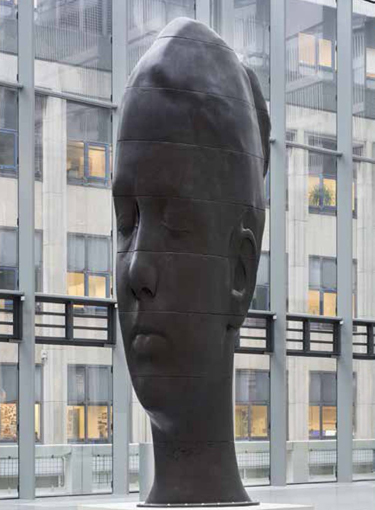
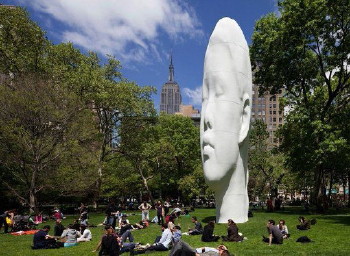 Picture 1
Picture 1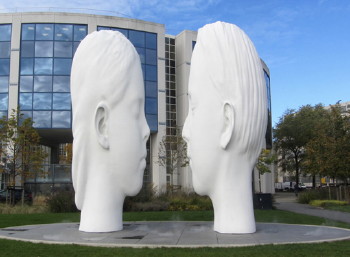 Picture 2
Picture 2